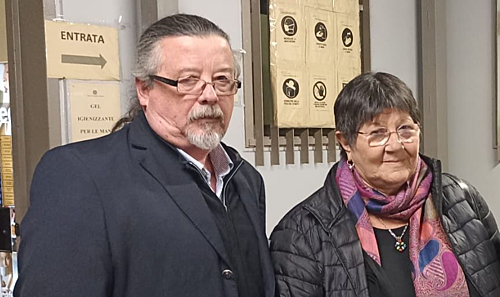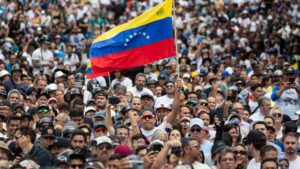
“Liar,” said former Uruguayan colonel Jorge Néstor Troccoli to Uruguayan journalist Roger Rodríguez who testified this morning (16/03) in the Third Court of Assisi of the Court of Rome.
The statement was given in a low voice when the journalist left the witness stand and headed for the exit. The witness retorted the offense seconds later, when he passed in front of the accused and stated: “I’m not a liar and you know I can prove what I said”.
Troccoli, 81, is already serving a life sentence for crimes committed during Operation Condor against Italian citizens. He is currently in the Gian Battista Novelli prison in Carinola, in the province of Caserta.
A former officer of the Secret Service of the Uruguayan Navy (Fusna), he is now responsible for the death and disappearance of the Italian-Argentine couple Rafaela Filipazzi and José Agustín Potenza and for the disappearance of the Uruguayan teacher Elena Quinteros, a member of the People’s Victory Party (PVP ).
Operation Condor was a collaborative network between dictatorships in South America that aimed to repress political opposition between the 1970s and 1980s.
According to Rodríguez, another aspect of Operation Condor was “that each State was responsible for killing its own political prisoners, or ‘its own trash,’ as repression referred to them”.
The journalist has been investigating cases of human rights violations committed during the Uruguayan military dictatorship for years. According to him, the collaboration between Argentina and Uruguay began in January 1974, even before Operation Condor.
“This collaboration was born to arrest Uruguayan political prisoners who were in Argentina. At first, it involved exchanging information about the exiles, later they also began to exchange prisoners illegally. In November 1974, six people were arrested in Argentina and taken to Uruguay, including a boy, who was the first missing child. After thirty years, I had the opportunity to interview Júlio Abreu, the only survivor of that episode. From 1975 [ano em que se iniciou a Operação Condor]repression exploded,” said Rodríguez.
According to the witness, Troccoli fled Uruguay when the country began investigating crimes against humanity. Some soldiers who shared operations with him were convicted. Rodríguez recalled that, like Troccoli, Mato Narbondo, another Uruguayan soldier convicted in the Condor Process in Rome, also left the country due to investigations involving his name. “Today, Brazil is analyzing Italy’s request for him to serve his sentence in a prison in Brazilian territory,” he said.
Regarding Troccoli, the journalist said he had access to various documents that demonstrate that the former soldier was in Buenos Aires in November 1977, including a passenger list that shows Troccoli’s name on seat 37, and that also contains the name of two other officers.
According to Rodriguez, it was precisely in December of that year that the Uruguayan government became more rigorous in its repressive activities. The first missing ones are from 1978.
“Troccoli himself admitted in the book he wrote, called ‘The Wrath of Leviathan’, that he went to Buenos Aires to take courses at the Mechanics School of the Argentine Navy (Esma)”, added the journalist, mentioning one of the best-known torture centers of the dictatorship of that country.
“Quinteros was in Fusna before his disappearance”
Historian Álvaro Rico, whose testimony began around 2:30 pm, presented the historical context, confirming the testimony of Italian researcher Francesca Lessa, in a hearing held in February. Rico stated that the relationship between S2 and S3 agents [órgãos de inteligência uruguaios] was narrow and the heads of each of these entities [Troccoli e Juan Carlos Larcebau] were constantly exchanged with each other. “Troccoli was from S3 and then S2,” she explained.
“The arrest of [Elena] Quinteros is a proven fact. There is no doubt about that, just as there is no doubt that this arrest took place in a context of very strong repression against the PVP”, said the historian.
However, there is controversy over where Quinteros was imprisoned: the first version says that she was taken to the “300 Carlos” center, but the statement by Captain Álex Lebel, in November 2000, states that Quinteros was imprisoned in a building of the Fusna before its disappearance.
“According to a journalist’s sources, the officers who participated in the Quinteros prison operation were Larcebau and Troccoli. Lebel was called to answer again before the Court if that journalist’s information was true and he said that ‘it is not incorrect’”, Rico said.
On November 17, 2000 Level stated to the Uruguayan court of honor that Quinteros was imprisoned in Fusna prior to her disappearance.
the victims
Elena Quinteros was kidnapped in Montevideo on June 24, 1976 and taken to a clandestine detention center. On June 28, she pretended to deliver a companion in an area close to the Venezuelan embassy. Quinteros managed to escape and enter the gardens of the diplomatic headquarters, where she asked for asylum, but Uruguayan officials entered the embassy and arrested her.
This led to a break in diplomatic relations between the two countries. Quinteros was a member of the Vitória do Povo Party (PVP) and was taken to a torture center. After that, she was never found again. In a file from the Fusna archives, she appears as dead between November 2nd and 3rd, 1976.
Filipazzi and Potenza were kidnapped in Montevideo on May 27, 1977 at the Hotel Hermitage and handed over to the S2 unit of the Marine Corps (Fusna). Some time later, they were transported by plane to Asunción and received by agents of the Alfredo Stroessner dictatorship.
According to investigations, they were murdered in Paraguay, where their remains were found, in March 2013.
Opera Mundi is the only Brazilian press vehicle that, since 2015, has followed the trials in Italy of crimes committed by torturers in the Southern Cone within the scope of Operation Condor.
Source: www.brasildefato.com.br

